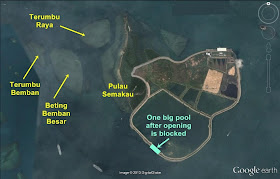Indeed, I noticed bleaching and stressed marine life on our last predawn survey of Northern Pulau Semakau. And very very sad seagrass situation. But still, some nice encounters with marine life.
There were many Frilly sea anemones, I saw two that were bleaching. I saw one Magnificent anemone and two Bubble tip anemones, both seemed alright but I could not find anemonefishes in both of them.
About 1% of the corals that I saw were bleaching. Many more had bleaching patches. As usual, the most abundant corals were Favid corals. Most of the corals including those along the reef edge were boulder-shaped ones.
About half of the Anemone corals I saw were bleaching with portions of the colony covered with scum, possible dead or dying. I saw one colony of Small goniopora coral that seemed pale.
About 80% of the Brain corals I saw were very pale, yellowish or were bleaching.
I think this is a Cabbage coral which is rather uncommon. Alas, it looks like its starting to bleach.
I saw a few Crinkled sandpaper corals and Cauliflower corals and all were not bleaching. I saw one small Acropora coral in deeper water that seemed alright. And a few small Carnation corals that were alright.
There were small clusters of Branching montipora coral on the reef flats here and there.
I saw two Galaxy corals with dead portions in the middle of the colony.
I saw a few Asparagus corals and they seemed alright. Most of the Leathery soft corals I saw seemed alright, except for one which had very pale yellowish tips.
There are many patches of Feathery soft corals and Zoanthids of all kinds on the shore. I came across one small patch of zoanthids that was bleaching.
Chocolate sponges were abundant and covered large areas, the next most abundant being the Smooth sponge green seaweed. There were also many other kinds of sponges.
I came across this clump of sponges that was very pale with portions that look like they were melting or dead.
What is coral bleaching and why this is of concern on the Bleach Watch Singapore blog. Fortunately, the latest Bleaching Alert Areas from the NOAA website shows that Singapore now falls outside the 'Watch' status. Let's hope our corals have passed the danger period for the year.

This is what it used to look like (photo taken in 2008)
The Tape seagrasses are still cropped short.
There were sparse patches of various kinds of seagrasses. In some parts, the ground is supersoft, I sank to nearly my knees.
The only patch of long Tape seagrass I saw was growing among long Sargassum seaweed. We already noticed the disappearing seagrasses on our last trip here in Oct 2014.
At sunrise, I came across this little Reef octopus hunting on the reef. These creatures are common on our reefs and active in the dark. But hardly to be seen after the sun rises.
It was a Malayan water monitor! It stayed motionless while I took the photo. But I moved away soon after so it could breathe and go about its business. This is not the first time I've seen the monitor lizard submerged on our reefs. So much more to learn about even our common large animals living on our shores!
I was so busy looking at how the corals and seagrasses were doing, I missed all the great finds that the team made. As usual, Kok Sheng has compiled and posted instantly all the special encounters on facebook. These include a Fluted giant clam spotted by Chay Hoon and special sea cucumber and flatworm.
Fortunately, we did not encounter any fish nets or traps on the shore. It may be because the shore no longer has fishes due to the loss of seagrasses? Oh dear.
Pulau Semakau is NOT the same as the Semakau Landfill. The Landfill was created by destroying all of Pulau Saking, and about half of the original Pulau Semakau by building a very long seawall. Fortunately, the landfill was constructed and is managed in such a way that the original mangroves, seagrass meadows and reefs on Pulau Semakau were allowed to remain. It is NOT true that the construction of the Landfill created the marine life found on Pulau Semakau. The marine life was there long before the Landfill was built.
As the existing half of the Landfill was used up, the Phase 2 of the Landfill was just recently launched. This involved closing the gap of the seawall on the Semakau Landfill, forming one big pool where incinerated ash will be dumped. NEA worked to limit the damage to natural shores during the construction work for this expansion of the landfill.
The northern shore of Pulau Semakau is opposite Pulau Hantu and the petrochemical plants on Pulau Bukom.
We get a bit of a break before our last morning low spring tide trips for the year in August. After which the tides turn to the evening until next year.
Posts by others on this trip
- Russel Low on facebook.
- Jonathan Tan on facebook.
- Loh Kok Sheng on facebook.
- Neo Mei Lin on her blog.
- Juria Toramae on facebook.























